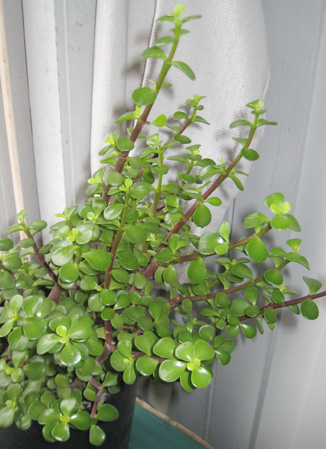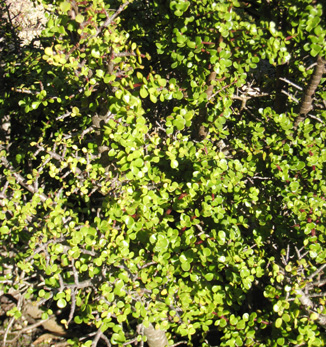| Since spring of 2002 when I learned about this plant during a visit to Arizona, I've grown it off and on in my Seattle garden. The pattern goes like this: I plant it in summer; it gets hurt or killed in winter. It survives a mild winter, but prolonged, strong freezes are too much. Because the Seattle winter this month was so unusually cold, I brought my Elephant Bush indoors. I had bought it at a local nursery last June for $7.98. |
| Elephant Bush has been cultivated in England since 1732; by 1855 in Australia; by the late 1800s or early 1900s in the United States. |
| I am promoting Elephant Bush because it is attractive, easily grown either as a houseplant, or outside, in sun or partial shade, and is edible. It is also easily propagated from cuttings, and readily available in both plain green and variegated versions. To grow it, just pluck a leaf or a stem, let it dry a few days, then put it in moist sand. It will root. |
| This plant is related to the common weed Purslane (about which I wrote a simple little article in 1986: click. Purslane is Portulaca oleracea, named thus in 1753 by Linnaeus. The specific name oleracea means edible. |
| Elephant Bush (or Elephant Plant; Elephant Grass; Elephant's Food) was named Portulacaria in 1786 by Nicolaus (Nicolaas) Joseph von Jacquin (1727-1817). That generic name refers to its resemblance to genus Portulaca. The name afra means of Africa. (The name Elephant Grass is more often applied to Pennisetum purpureum --in the news as a bio-fuel crop.) |
| Elephant Bush grows in semi-arid South Africa and Kenya, on dry rocky sites mostly. Unlike Purslane, which is a cold-tender summer-annual weedy herb, Portulacaria is a stout shrub or even small tree 15 (rarely 20) feet tall with a trunk that can be 3 feet thick. It greatly recalls a Jade Plant. In fact other names are Baby Jade, Miniature Jade, Tiny-leaf Jade, Dwarf-leaf Jade, and Chinese Jade. A Xhosa name is iGwanishe or iGwanitsha. Zulu names include: isAmbilane, isiCococo, inDibili-enkula, umDondwane, iNdibili, and iNtelezi. |
| Its Afrikaans name Spekboom means Pork Wood --Bacon or Fat Tree. Some specimens taste better than others according to the level of tannins in the foliage. |
| In mild parts of Arizona and southern California it can make luxurious massive plants, sprawling all over. In Seattle, I suppose it may get as big as I can handle --except that I tend to eat it, much as an animal might browse it. The leaves are juicy, crunchy and mildly sour in an agreeable way. I have only consumed it raw. Elephants, goats and other animals eat these plants in South Africa. It is said to be an elephant staple in Addo Elephant National Park. The leaves are plump, glossy, broadest above their middle, and usually less than an inch long. |
| It has small pink flowers (June to October) of no spectacular fashion in late spring or early summer. But they are sweetly scented, and attract bees, which can make good honey from them. The flowers give rise to translucent little fruits with 1 tiny seed. In cultivation, flowers are rare usually. |
| It tolerates formal shearing for hedges. It is much used in bonsai. Its wood is "spongy and useless" and its branches very brittle. |
Some cultivars are:
|
'Aureum' (leaves golden in middle)
|
var. foliis-variegatus Jacobsen (leaves mottled yellow; called the Rainbow Bush)
|
var. macrophylla Jacobsen (leaves bigger)
|
var. microphylla Jacobsen (leaves smaller)
|
'Tricolor' (pendulous habit; leaves variegated green, yellow and pink --also called the Rainbow Bush
|
'Variegata' (leaves pale green, creamy-margined and pink-edged)
|
| The variegated clones are smaller and less robust than the plain green ones. It is likely that some mislabeling goes on, so identical plants may be bought under different names. |
| There is one closely related species of Portulacaria. P. armiana van Jaarsv. was published in 1984, for a Cape Province species with larger leaves. I wonder if the var. macrophylla Jacobsen is actually this. |
| A closely related genus is Ceraria. |
| For far more information than I provide above, here is a link to Robert J. Baran's webpage all about this species: (www.phoenixbonsai.com/Portulacaria.html) |
I share three photos below.
Back |

young Elephant Bush indoors in a pot (photo by ALJ)
|

old Elephant Bush outside (photo by ALJ)
|

pendulous Elephant Bush from Home Depot (photo by ALJ)
|

